Introduction
The aim of the paper is to study immigrant labor market in Canada. In particular, the paper aims to compare the average earnings of an immigrant group, the other immigrant groups, and the Canadian-born citizens in order to understand the wage difference between the three groups based on gender and other demographic variables. The immigrant group that is studied is Indians in Canada. The second is the “other” immigrant group who may be Asian, European, Australian, or African. The third are the original inhabitants of Canada.
Previous researches have concentrated to study the nature of immigrant earnings using US immigrants’ data. Studies on Canadian immigrant earning has been conducted by Bloom, Grenier, Gunderson (988) shows that the Canadian born individuals is higher than that of the immigrant groups however the growth of income of the immigrants is higher than the Canadian born individuals.
Current researches have concentrated to understand the ethnic difference in labor market earnings based on racial discrimination (Pendakur and Pendakur 519). Such researches have concentrated on finding the difference in the earning of racial groups based on their skin color (i.e. whites and non-whites). A study conducted by Abbott and Beach studies the earning differential especially between male immigrants in Canada from the nineteen forties to the seventies (507). However, these studies were mostly done in the nineties and recent studies on the labor market differential are few.
Hence, a more recent study was necessary to understand the difference in earnings of immigrant labors vis-à-vis to the citizens of Canada. Further, there are studies on earnings of immigrant Chinese in Canada (Wang and Lo 36) but no study has been found that shows the earnings difference between Indian immigrants and that of the Canadian citizens. The paper will first provide a methodology and data related information and then move on to analyze the data in order to bring forth relevant information about the income of the three groups.
Methodology and Data
The study aims to understand the economic assimilation of the Indian born immigrants’ earnings to that of the native born and the other immigrant groups. Previous studies have suggested that the immigrants’ income are initially lower than the native’s however, with higher growth of earning, their income surpasses that of the natives quickly (Bloom, Grenier and Gunderson 989). This paper will study these two questions detailed in the literature, and will check the validity of this research question based on the data collected from the 2011 National Household Survey. The study will compare the earnings of Indian immigrants with that of the natives and that of the other immigrant groups based on gender and other demographic variables.
The economic analysis of how the Indian immigrants’ earnings change and compare to that of the other groups. A regression analysis on the data allows an understanding of the dependency of the change of the wages on other factors like age, marital status, education background, and years of migration. As there is only one cross-section, no cohort effect is detected. The model that is used to do the study is:
lny=Xβ + αIO+ γIG + δ(YSM×I) + u
Where, lny = natural logarithm of annual earnings (labor income); X = vector of personal characteristics (age, age squared, schooling, location of studies, marital status, weeks worked, indicator for full time or part time work); β = vector of regression coefficients; α = regression coefficient indicating the entry effect for other (than your group) immigrants; IO = dummy variable taking the value 1 for other immigrants and the value 0 otherwise; γ = regression coefficient indicating the entry effect for your group of immigrant; IG = dummy variable taking the value 1 for your group of immigrants and the value 0 otherwise; δ = regression coefficient indicating the assimilation effect for immigrants (in this specification, assumed to be the same for your group and for other immigrants); YSM = number of years since migration of the immigrants; I = 1 for all immigrants, =0 for non-immigrants; u = regression error term.
The data that is used are from three groups – Indian immigrants, other immigrants, and non-immigrant Canadians. The data is collected for individuals above the age of 20 and less than 64 years. The data is then segregated based on the education background, marital status, gender, age, and number of years migrated to Canada. The job related questions address number of weeks worked in 2010, the nature of work (whether it is full-time or part-time), wages. The analysis is based on this data segregation. The data collected is statistically analyzed using descriptive statistics and then are regressed based on the demographic variables.
Analysis of the Result
The paper analyzes the descriptive statistics and then explains the results of the regression analysis of the three groups understanding the nature and degree of assimilation of Indian immigrants vis-à-vis other immigrants and that of the native-born Canadians.
Table 1 shows the descriptive statistics for the men and women immigrants divided into three groups. The data of the men show that the average age of the Indian immigrants is 42.64 years with minimum age bring 22 and the maximum 62. This shows that the limit set for the study is maintained for the case of male Indian immigrants and that for all other male immigrants/non-immigrant groups. In the women’s section, the minimum, and maximum age ranges between 22 and 62 years. The mean wage of the Indian immigrants is at $44116.9, which is lower than that of other male immigrants who earn a mean wage of $47372.15, and considerably lesser than the non-immigrant Canadians, who have a mean wage of $51155. The mean age of the Indian immigrants is 42.6 years and that of the other immigrants and non-immigrants are 44 and 40.9 years respectively. The mean age of the Indian immigrants falls in-between the mean age of the other immigrants and that of the non-immigrants.
Table 1: Descriptive Statistics of the data collected for year 2010
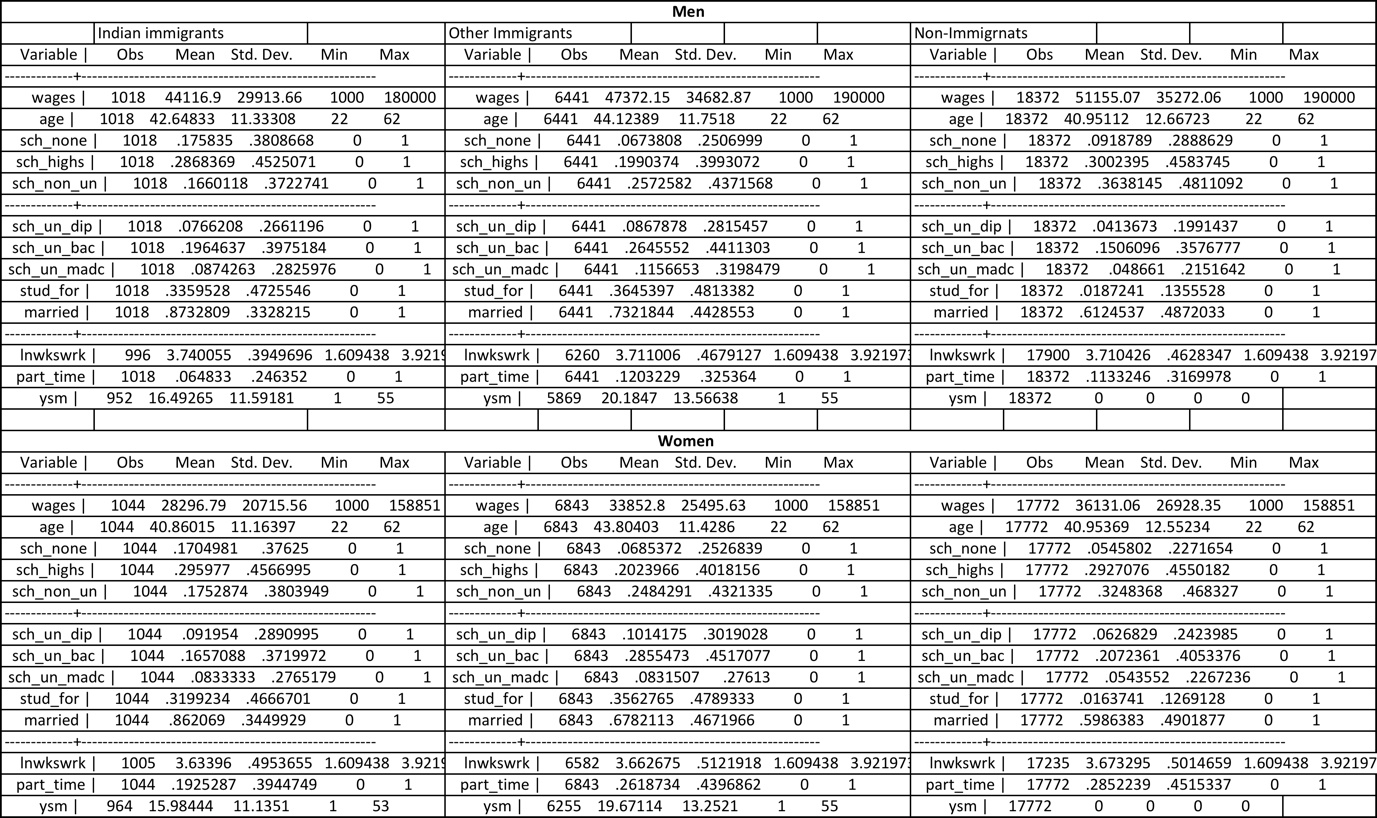
The education level of the groups is varied. The mean number of individuals who have no schooling among Indian immigrants is higher (0.175) compared to other immigrants (0.067) and non-immigrants (0.095). Mean high school degree among Indian immigrants is 0.286 while that among other immigrants is 0.199 and that among non-immigrants is 0.3. This shows that the Indian immigrants have more high school degree, however, in terms of higher degree i.e. bachelor and post-graduate and above, Indian immigrants have a mean bachelor degree of 0.196 and PG or above of 0.087, while that of other immigrants is 0.264 and 0.1156, and that of non-immigrants is 0.15 and 0.0486.
In terms of higher education, Indian immigrants have less bachelor’s and masters and above degree than other immigrants but have more from the non-immigrants. Number of weeks worked for all three groups are similar at 3.7 week on average. Non-immigrants do more part-time jobs vis-à-vis full time jobs. Indian immigrants have migrated for a mean of 16 years while other immigrants have the same of 20 years. However, the situation is different for women. The mean number of bachelor degree holder among Indian immigrant women is lesser than that of other immigrants and non-immigrants. However, master degree holders are more among Indians than among other immigrants and non-immigrants. Part-time work done by women other immigrants and non-immigrants is much higher than men and the women Indian immigrants.
The descriptive analysis shows that there is a distinct difference in the wages earned among immigrants based on gender. Indian male immigrants have a higher mean wage ($44116.9) than that of the female immigrants ($28296.79) even though their mean level of education is similar for high school pass outs, bachelor degree holders, and masters or doctorate holders. The within-group comparison for the two genders show that Indian immigrants ear much less than the other immigrants and non-immigrants. This difference in pay may be attributable to the lesser number of years they have stayed in Canada, education qualification, and immediate relocation cost.
Table 2 and 3 shows the regression of the wages of male and female Indian immigrants respectively with respect to wages earned by other and non-immigrants. In both the cases, a significant difference in wages has been found with the non-immigrant Canadians. Clearly, the native Canadians warn much higher wages than the Indian immigrants.
Table 2: Regression of native Indian male w.r.t. other immigrants and Non-immigrants
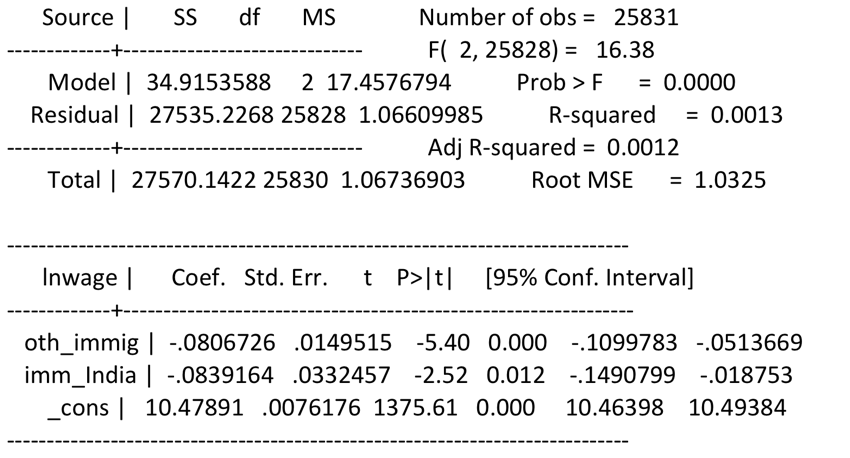
Table 3: Regression of native Indian female w.r.t. other immigrants and Non-immigrants
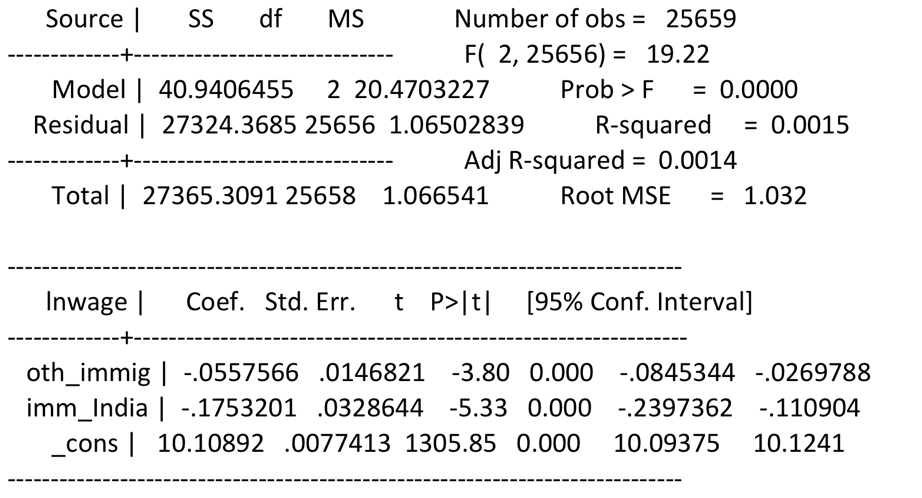
Table 4 and 5 presents the regression analysis of male and female Indian immigrants with regard to all variables respectively. The regression shows that more age has a positive effect on the wages earned (0.083 co-efficient) indicating that higher the age of the individual more would be the wages earned. In other worlds, more is the experience of the individuals higher is the wages he/she earns. No significant relation has been found between the education parameters such as university attendance without degree, bachelor degree, and diploma degree holders.
However, statically significant results have been found for wages relation with masters or above degree holders, high school graduates, and no degree holders. No degree holders and high school degree has a negative effect on wages earned while a masters and above degree has a positive effect on the wages earned by individuals. Years of migration have a statistically significant positive effect on the wages earned by both male and female Indian immigrants.
Table 4: Regression for male Indian immigrants w.r.t. all variables
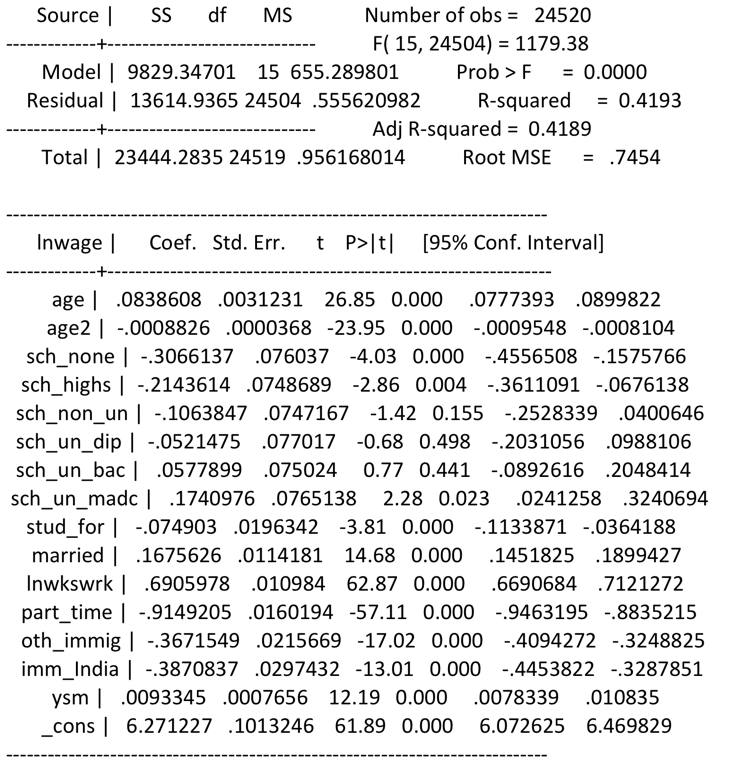
Table 5: Regression for female Indian immigrants w.r.t. all variables
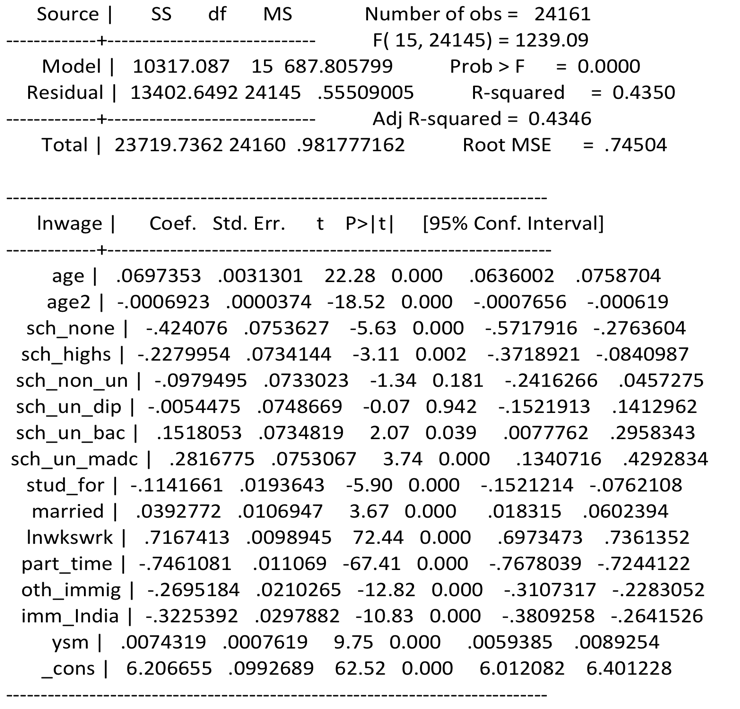
Conclusion
The data analysis shows that there is distinctive differences between wages earned by Indian immigrants vary greatly by gender. The difference is greater among women Indian immigrants than that of male Indian immigrants. The economic assimilation between the Indian immigrants and the other immigrants and native Canadians will reduce as years of migration increases. Economic assimilation can occur in various dimensions, as the employment status of immigrants initially may be sporadic. When immigrants land on Canadian soil, they may remain unemployed for a certain period. Thus, their initial employment may be ones that are lower than the native born individuals are, but soon they catch up with their employment status. Therefore, higher the year of migration, lesser will be the difference in wages earned between the three groups. The present study’s findings adhere to the earlier findings of immigrant labor market.
Works Cited
Abbott, Michael G. and Charles M. Beach. “Immigrant earnings differentials and birth-year effects for men in Canada: post-war-1972.” Canadian Journal of Economics 26.3 (1993): 505-524. Print.
Bloom, David E., Gilles Grenier and Morley Gunderson. “The changing labor market position of Canadian immigrants.” Canadian Journal of Economics 28.4 (1995): 987-1005. Print.
Pendakur, Krishna and Ravi Pendakur. “The colour of money: earnings differentials among ethnic groups in Canada.” Canadian Journal of Economics 31.3 (1998): 518-548. Print.
Wang, Shuguang and Lucia Lo. “Chinese Immigrants in Canada: Their Changing Composition and Economic Performance.” International Migration 43.3 (2005): 35-71. Print.